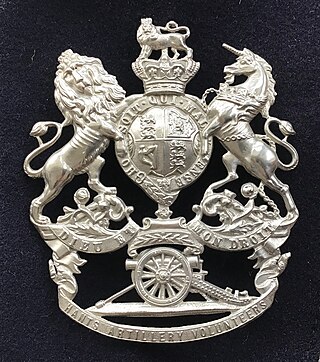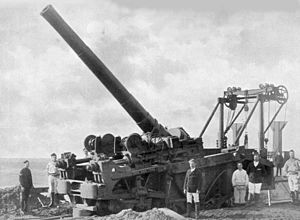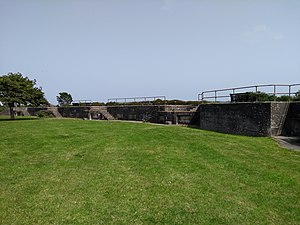1st Anti-Aircraft Brigade was an Air Defence formation of the British Army, during the Second World War, and served in the Battle of France and during The Blitz. It then transferred to the Middle East, where it defended the Eighth Army's lines of communication during the final phases of the North African Campaign.
The Tynemouth Volunteer Artillery claims to be the oldest volunteer artillery unit of the British Army. It served coastal and siege guns in World War I and World War II, and also served in the infantry role.

56th (Cornwall) Heavy Anti-Aircraft Regiment, Royal Artillery was a volunteer air defence regiment of Britain's Territorial Army (TA). Originally raised in 1920 as a medium artillery regiment, it was converted to the anti-aircraft role in 1932. During the Second World War, it was employed in Home Defence, in Iceland and then in India, where it was temporarily converted back to medium artillery. Postwar, it reverted to air defence until disbandment in 1955.
The 1st Durham Volunteer Artillery was a unit of Britain's Volunteer Force and Territorial Army from 1860 to 1956. During World War I, it was the only coastal defence unit to engage the enemy, and it also trained siege gunners for service on the Western Front. It continued its coast defence role in World War II, after which it was converted into air defence and engineer units.

The Cornwall Fortress Royal Engineers, was a volunteer unit of Britain's Royal Engineers formed in 1908. It helped to defend the coastal towns of Cornwall and sent engineer units to work on the Western Front. Converted to an air defence role before World War I, it served as a searchlight unit during the Battle of Britain, the Blitz, then, as a light anti-aircraft gun unit, it served in the most heavily attacked part of the South Coast of England throughout 1942–44, including the V-1 flying bomb campaign.

The 1st Cornwall Artillery Volunteers were formed in 1860 as a response to a French invasion threat. They served as a Coast Artillery unit during both World Wars, and also manned batteries serving overseas. The unit continued in existence until the dissolution of Coast Artillery in the UK in 1956.

The 1st Devonshire Artillery Volunteers and its successor units served in the British Army's Reserve Forces from 1859 to 1961. During World War I it carried out garrison duty in British India but went on to see active service in the Third Anglo-Afghan War. Converting to an air defence role before World War II its units participated in the Norwegian campaign and the Dunkirk evacuation, the Battle of Britain and then the campaigns in North Africa, Italy, and Burma
The 1st Kent Artillery Volunteers was a part-time unit of the British Army's Royal Artillery from 1860 to 1956. Primarily serving as coastal artillery defending the Port of Dover and other harbours in South-East England, the unit's successors also served in the heavy artillery role on the Western Front during World War I and as anti-aircraft artillery during the Blitz and later in the North African and Italian campaigns of World War II.

The East Riding Royal Garrison Artillery (ERRGA) was a part-time unit of Britain's Royal Artillery based at Hull in the East Riding of Yorkshire. It provided coastal defence artillery along the Humber Estuary from 1908 to 1956, manned siege batteries on the Western Front during World War I at the Somme and Ypres and played a role in the pursuit of the German army during the Hundred Days Offensive. It served as infantry in Allied-occupied Germany after World War II. Its successor units in the Territorial Army included anti-aircraft artillery and field engineers.

The South Midland (Warwickshire) Royal Garrison Artillery was a volunteer artillery unit of Britain's Territorial Force formed in 1908. It served in Home Defence and provided heavy artillery support to the armies on the Western Front and Italian Front in World War I. In the interwar years it became 204 (Warwickshire) Battery serving in various regiments and formations before being expanded into a full regiment. In World War II it served in the heavy anti-aircraft (HAA) role defending its home area of the West Midlands against German air attack, and then defended Calcutta against Japanese attacks. It continued in the postwar Territorial Army until 1955.

The 2nd Glamorganshire Artillery Volunteers was a part-time unit of the British Army that defended the coast of South Wales from 1890 to 1942. Although it never saw action in its coastal defence role, it formed several siege batteries of heavy howitzers for service on the Western Front and Italian Front in World War I.

The Pembroke Royal Garrison Artillery was a part-time unit of the British Army that defended the coast of West Wales during both world wars. Although it never saw action in its coastal defence role, it manned a number of siege batteries of heavy howitzers for service on the Western Front and Italian Front in World War I.

The North Scottish Royal Garrison Artillery and its successors were Scottish part-time coast defence units of the British Army from 1908 to 1961. Although the unit saw no active service, it supplied trained gunners to siege batteries engaged on the Western Front during World War I.

The Clyde Royal Garrison Artillery and its successors were Scottish part-time coast defence units of the British Army from 1910 to 1967. Although they unit saw no active service, they supplied trained gunners to siege batteries engaged on the Western Front during World War I.

The Forth Royal Garrison Artillery and its successors were Scottish part-time coast defence units of the British Army from 1908 to 1956. Although they saw no active service, they supplied trained gunners to siege batteries engaged on the Western Front during World War I.

The 1st Hampshire Artillery Volunteers and its successors were part-time coast defence units of the British Army from 1860 to 1967. Although the units saw no action, they protected the Portsmouth area in both World Wars and supplied trained gunners to siege batteries engaged on the Western Front during World War I. The unit continued in the Territorial Army after World War II.

The Orkney Heavy Regiment was a Territorial Army unit of Britain's Royal Artillery raised in the Orkney Islands just before World War II. During the war it was greatly expanded to defend the vital naval base of Scapa Flow. It was reformed postwar and later became an air defence battery.

The 1st Dorsetshire Artillery Volunteers and its successors were part-time coast defence units of the British Army from 1859 to 1956. Although these units saw no action, they protected the Dorset Coast, including the naval base of Portland Harbour, in both World Wars and also supplied trained gunners to siege batteries engaged on the Western Front during World War I. The unit continued in the Territorial Army after World War II.

The 1st Lancashire Artillery Volunteers, popularly known as 'Brown's Corps', was an auxiliary unit of the British Army raised in Liverpool in 1859. As the Lancashire & Cheshire Royal Garrison Artillery in the Territorial Force it was responsible for defending the Mersey Estuary and the coastline of North West England. It was one of the few coast defence units to fire a shot during World War I but also provided personnel for a number of siege batteries that saw action on the Western Front. It continued in the coast defence role during World War II, at the end of which it sent troops to work in the rear areas in Europe. It was reformed postwar but was broken up when the coast artillery branch was abolished in 1956.

The 1st Suffolk & Harwich Volunteer Artillery, later the Essex & Suffolk Royal Garrison Artillery was an auxiliary coastal artillery unit of the British Army first raised in 1899. It defended the ports and naval bases around the estuaries of the Rivers Orwell and Stour. Although the unit saw no active service, it supplied trained gunners to siege batteries engaged on the Western Front during World War I. It was greatly expanded in World War II to defend the invasion-threatened East Anglian Coast from Harwich to Great Yarmouth. Postwar it continued in the coast and air defence roles until it disappeared in a series of amalgamations from the 1950s.











